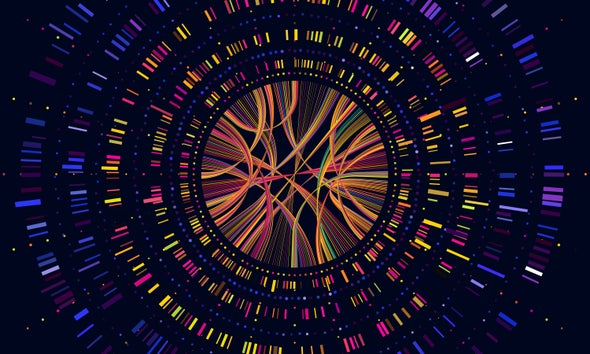(单词翻译:单击)
听力文本
This is Scientific American's 60-second Science, I'm Christine Herman.
Got a minute?
Some scientists want to use the DNA of indigenous people to reconstruct the "human migration story": that's the history of how people spread from Africa to everywhere.
But many in the indigenous community who've contributed their DNA for science feel these types of studies are exploitative—and say they don't like being left out of the conversation.
"There's a long history about anthropologists and scientists going to indigenous communities, getting what they need, leaving and never coming back."
University of Illinois anthropologist Ripan Malhi.
"I learned early on that that was the norm in science and anthropology up until recently."
To help change that system, in 2011 Malhi launched a program that provides hands-on genomics training to Native American and other indigenous scientists—and laypeople. It's called SING (Summer Internship for Indigenous Peoples in Genomics).
"We discuss all week about genomics and how it can be used as a tool and how it may fit or not fit with indigenous ideas and knowledge. We have discussions on how to decolonize science, and then we do a large number of discussions about ethical, legal and social implications."
This year's SING workshop wrapped up earlier this month. Krystal Tsosie is a Navajo geneticist and one of the organizers.

"SING has been influential in training the next generation of indigenous scientists, so that we can ensure that science is done by us, for us—and truly benefits us."
Tsosie says she's the only indigenous Ph.D. student in science at Vanderbilt (University), and the SING workshop has helped her feel less isolated.
"So getting that sort of sense of community from my indigenous peers who are undergoing the same sort of challenges in academia is great."
SING has trained more than 120 participants to date. In 2018 alumni and faculty published ethical guidelines for scientists on how to approach genomics research in a way that is sensitive to the interests of indigenous people and that can benefit their communities.
Malhi says he now approaches his work with indigenous communities as a collaboration.
"I work with the communities to figure out what they want to study, as well as what we want to study, and basically partner with them."
In her research, Tsosie studies pregnancy complications among Ojibwe women in North Dakota and how environmental factors contribute to disease among indigenous communities in South Dakota.
She says partnering with Indigenous people is critical...
"... to ensure that genomics research that involves indigenous people will actually benefit us, as opposed to just using us as subjects, as we have in the past."
Thanks for the minute for Scientific American — 60-Second Science. I'm Christine Herman.
参考译文
这里是科学美国人——60秒科学系列,我是克里斯汀·赫尔曼。
有一分钟时间吗?
一些科学家想用土著人的DNA来重建“人类迁徙故事”:即人类如何从非洲散布到世界各地的历史。
但在土著群体中,许多为科学贡献了自已DNA的人认为,这类研究具剥削性,他们不喜欢被排除在对话之外。
“很长时间以来,人类学家和科学家会进入土著社区,得到他们所需要的东西,然后离开,再也不回来。”
伊利诺利大学的人类学家里潘·马里说到。
“我很早就知道,直到最近这一直是科学界和人类学的常态。”
为了帮助改变这种状态,马里在2011年启动了一个项目,为美洲土著、其他土著科学家以及外行人提供基因组实际培训。这一培训名为土著基因组学研究夏季实习(简称SING)。
“我们整个星期都在讨论基因组学,如何将其用作工具,以及其适合或不适合本土想法和知识。我们讨论了如何使科学非殖民化,之后还就伦理、法律和社会影响进行了大量讨论。”
今年的SING研讨会于本月早些时候结束。克里斯托·苏西是纳瓦霍族遗传学家,也是研讨会的组织者之一。
“SING项目在培养下一代土著科学家方面具有影响力,因此我们可以确保科学由我们自已完成,为我们服务且真正造福于我们。”
苏西表示,她是范德比尔特大学唯一一位土著理科博士生,而SING研讨会减少了她的孤独感。
“从土著同龄人那里获得那种社区意识非常棒,他们在学术界也面临着同样的挑战。”
迄今为止,SING已经培训了120多名参与者。2018年,校友和教师为科学家发布了伦理指南,指导他们如何以对土著民利益敏感并能惠及土著社区的方式进行基因组研究。
马里表示,他现在以合作的方式来处理其土著民社区的研究工作。
“我与社区合作,了解他们想学习的内容以及我们想学习的内容,基本上就是与他们合作。”
苏西研究了北达科他州奥吉布瓦女性的妊娠并发症,以及环境因素如何影响南达科他州土著社区的疾病。
她说,与土著人合作至关重要。
“这是为了涉及土著人的基因组研究能真正地造福于我们,而不是像过去那样仅仅把土著人当作研究对象。”
谢谢大家收听科学美国人——60秒科学。我是克里斯汀·赫尔曼。
译文为可可英语翻译,未经授权请勿转载!
重点讲解
重点讲解:
1. wrap up 圆满完成,圆满结束(工作、协议等);
NATO defense ministers wrap up their meeting in Brussels today.
北约各国国防部长今天圆满结束了在布鲁塞尔的会议。
2. to date 迄今;到目前为止;
To date there is no evidence to support this theory.
到目前为止,还没有证据支持这种理论。
3. be sensitive to 过敏的;易受影响的;敏感的;
Some of us are sensitive to smells, others find colours easier to remember.
我们当中的一些人对气味很敏感,而其他一些人则更容易记住颜色。
4. as opposed to 而不是;
This exercise develops suppleness as opposed to strength.
这项锻炼不是增强力量,而是增强柔韧性的。


